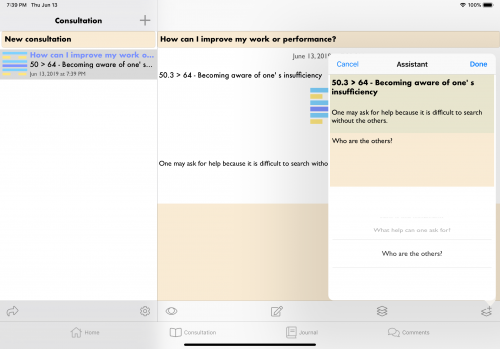Interpreting multiple lines: the pivot method revisited
The pivot method
When obtaining a multiple lines reading, you can use one line or groupe of lines as a pivot and amend it with the remaining line (or alternatively take one line as pivot and amend it with the remaining line or group of lines). This is what I call the pivot method. Some people read all the lines separately and my opinion is that the lines interact together, to alter the final meaning. When considering two lines transformations the pivot method works very well, with only a few difficulties. The problems arise when trying to interpret three or more changing lines. In this difficult task, we are helped by the comments given by the oracle: since we have the comments for multiple lines done already, it is relatively easy to check whether they make sense when organized that way or not. Finding the right way to interpret multiple lines, not only gives us the opportunity to validate the oracle's comments and see that they make sense, but also it reveals new insights about the situation.
Previous attempt
When I consulted the oracle about the interpretation of multiple lines, I received 63.3 as answer: One is hard at work to solve a problem, it will be painful. The most able will go first.
Since the fifth line traditionally represents the prince and the first line the subject, I have tried to consider the topmost line first and amend it with the lower line. My experiments are detailed in the previous article:
A promising methodology for interpreting multiple changing lines
However the results are mixed, sometimes satisfying , specially with two lines, and sometimes discouraging, and I considered abandoning the pivot method. Then by reading comments about a situation, I remembered that the chronological order was from bottom to the top. So, let us revisit the readings of the previous article and try to interpret them with the bottom first approach:
7.1.2
This one does not change, since we still read the first and the second line as before.


Situation
7 > 24 – Not being taken immediately
One must show to their relatives that they are ready to respect the choice of others.
The formation
7 – The will
To solve their problems, one will need discipline and continuity.
7.1 – Contradictions show falsity.
7.2 – One does like everybody else, therefore is trusted.
We can refine, the earlier interpretation in the following way: If one contradicts what everybody else does, they won't be trusted. Consequently one has to respect the choice of others, which is the actual comment of 7.1.2, and probably the basis of democracy.
7.1.2.3


Situation
One goes further than those who have been afraid to face the unknown.
The formation
7 - The will
To solve their problems, one will need discipline and continuity.
7.1 - Contradictions show falsity.
7.2 - One does like everybody else, therefore is trusted.
My argument was that:
One gives up on others. (7.3)One must show to their relatives that they are ready to respect the choice of others. (7.1.2)
makes less sense than:
One warns those who seek to stand out. (7.2.3)Contradictions show falsity. (7.1)
to obtain the following:
One goes further than those who have been afraid to face the unknown. (7.1.2.3)
Which seems true, at first glance. It is difficult to connect Giving up on others with Showing to their relatives that they are ready to respect the choice of others because they are contradictory.
This is because in the first case I have used 7.3 as the pivot and tried to amend it with 7.1.2. But what if 7.1.2 is the pivot?
One must show to their relatives that they are ready to respect the choice of others. (7.1.2)One gives up on others. (7.3)
This time we have to connect respect the choice of others to one gives up on others. The simplest way to interpret this with the pivot method is to take 7.3 as a kind of negation. So the interpretation becomes that One will not show to their relatives that they are ready to respect the choice of others. Thus, One goes further than those who have been afraid to face the unknown.
It makes more sense that way. When using 7.3 as the pivot, we cannot use it as negation.
Another way to interpret these three lines is to consider that the first line is about contradiction:
Contradictions show falsity. (7.1)
What are the contradictions? 7.2 and 7.3:
One does like everybody else, therefore is trusted. (7.2)One gives up on others. (7.3)
However interpreting like that would not match the comment of 7.1.2.3 that we have received from the oracle.
7.1.2.3.4
This is where things become really interesting in my opinion. In the previous post, I had only considered the topmost lines, so let see what we have here:


Situation
One explains to their opponents that it is necessary to find a compromise.
The pivot would be 7.1.2.3 and we will amend it with 7.4:
One goes further than those who have been afraid to face the unknown. (7.1.2.3)One prevents others from continuing, until one has restored their concentration. (7.4)
and we should obtain:
One explains to their opponents that it is necessary to find a compromise. (7.1.2.3.4)
One wants to go further but the others won't let them, thus it becomes necessary to find a compromise. If you compare with my previous post, I had given a very different interpretation with the other method. This is is why it is of the utmost importance to find the right method, so we can interpret these multiple lines correctly. As usual, the main way to validate these comments is to read real situations and their outcome whenever possible.
7.1.2.3.4.5


Situation
One joins those who want to highlight the most deserving.
One explains to their opponents that it is necessary to find a compromise. (7.1.2.3.4)Something useful can be obtained, the most experienced will be able to succeed, another would damage it. (7.5)
One joins those who want to highlight the most deserving. (7.1.2.3.4.5)
The compromise being that the most experienced will be able to succeed.
7.1.2.3.4.5.6


Situation
One had expected better conditions than those that really occurred.
One joins those who want to highlight the most deserving. (7.1.2.3.4.5)It is time to restore order after action, and for that one will need specialists. (7.6)
One had expected better conditions than those that really occurred. (7.1.2.3.4.5.6)
Someone has received less rewards than expected, this is also explained by the transformation 13, that shows a community of people, so one cannot receive all the rewards.
Real example
Recently, I have stumbled upon this thread at onlineclarity.co.uk: Career Readings 42.2.3.4>1 and 49.2>43
The question was about whether someone would be hired, the answer was 42.2.3.4 and this person did not get hired. If you read the three lines separately, the answer is totally positive, but if you use the pivot method you get another story. The comment that I got from the oracle for 42.2.3.4 is also difficult to grasp without a serious thinking about it.


Situation
42 > 1 - Staying away from the flame
One is going to be torched if they keep coming closer to the fire.
Actually, this sounds very negative. But, how can we relate to the fire and the flame in this situation? Let see what happens with the pivot method:
One supports their friends so they can be recognised. (42.2.3)When one needs something else they can admit it. (42.4)
As we can see, the interpretation can only be negative, this person won't be hired.
One is going to be torched if they keep coming closer to the fire. (42.2.3.4)
For the record, we can check 42.3.4 and amend it with 42.2:
One shows the newcomers everything they need to learn to be able to fulfill their promises. (42.3.4)Others offer to one to meet their representative before one decides to associate. (42.2)
This sounds very positive, and by following this method, without reading the comment for 42.2.3.4, I would have interpreted this as the person being hired.
What about the fire? I think it is about passion, commitment, or high activity. After envisioning various possibilities, it could be that the candidate is presented by an agency that is not trusted. They have played with the fire too much and in the end get burned.
Conclusion
While it would be dishonest to claim that this method is crystal clear, it shows interesting tracks that lead to a compatible interpretation. Naturally, since the changing lines turn into a new hexagram, the final interpretation has to take it into account. In the last example 42 transforms into 1, evolution, and another candidate has been hired.
Synchronicity
After publishing this article, I've noticed that Hilary Barrett has followed a similar route in her article: Multiple moving lines, revisited
While we have a disagreement about the comments, I totally agree with the interpretation method that she recommends.

